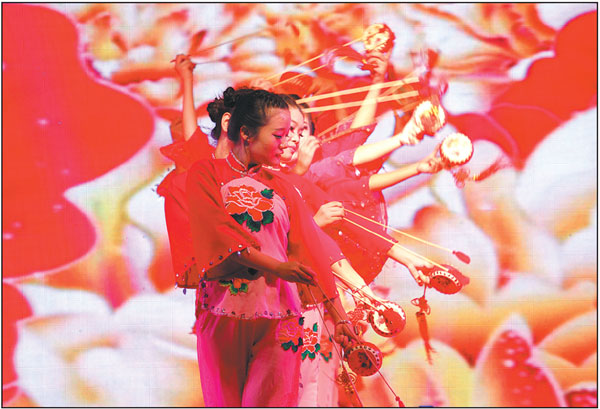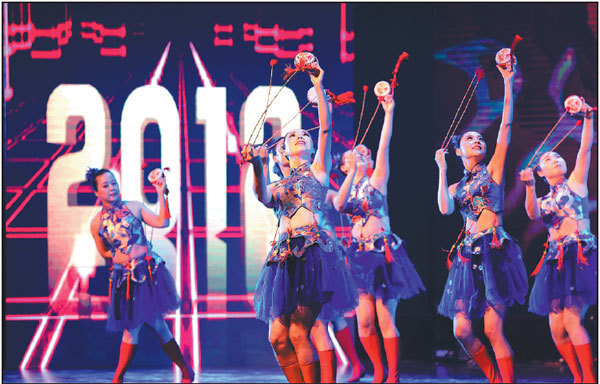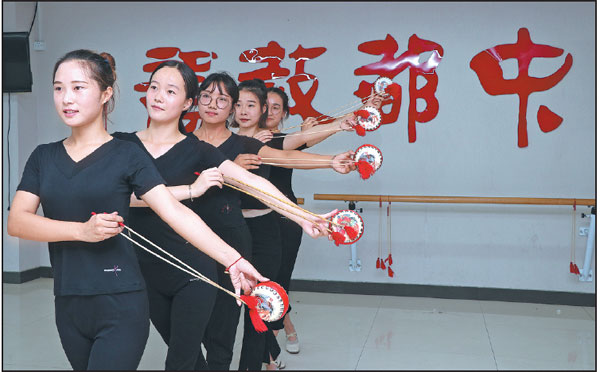Fengyang drum dance gets new lease on life
Traditional art injected with fresh vitality by troupe members at Anhui Science and Technology University
About three dozen college students, most of whom are juniors and sophomores, have been busy preparing for an annual campus performance to welcome the incoming freshmen.
With a small drum in the left hand, with phoenix painted on, and a pair of nearly half-meter-long sticks between the fingers of the right hand, the students not only dance but also make music with the drums.
The shows are regarded as some of the most important events taking place at Anhui Science and Technology University since first performed in the fall of 2013. The university is based in Fengyang county of East China's Anhui province.
People might think that the young students are performing modern music such as hiphop, rap, or modern dances that are popular among young people. That is, until they hear the lyrics.
"A gong in the left hand, a drum in the right, come and sing songs, with the gong and drum in both hands."
Many people from across China, especially the elderly, have heard these words but might know no more than that about this traditional folk art that originated in Fengyang. It is called the Fengyang flower-drum dance.
"People who watch the students' performance will know that the students' devotion is really significant for keeping this national intangible cultural heritage alive," said Zhang Cong, teacher and director for the performance.
An old folk art
Popular in the county, the Fengyang flower-drum dance has a history of more than 600 years. It was often considered as a performance form for the middle-aged and elderly people, before the young college students started to inject fresh vitality into the old folk art.
Fengyang county is the birthplace of China's rural reforms. In December 1978, after the collectivized farming policy had been in force nationwide for about 20 years, 18 farmers in the county's Xiaogang village secretly signed an agreement to subdivide their common farmland into family plots in the hope of increasing crop yields.
"Xiaogang village is very famous, so is the Fengyang flower-drum dance, but I didn't have more knowledge than merely the name before I came here in 2015," said Wu Yan, a junior from Hubei province who has been studying at ASTU.
A member of the university's student flower-drum dance art troupe, Wu was echoed by most of the other troupe members, who come from other parts of China.
Trick of beggars
China has many local operas, most of which were performed to celebrate happy occasions. But the Fengyang flower-drum dance originates from hard memories.
Although it was later called a dance, the art did not have much to do with dancing at first. It was more like telling stories while playing gongs and drums, according to Shi Peizhi, chief of ASTU's youth league.
Fengyang was the birthplace of Zhu Yuanzhang (1328-98), the first emperor of the Ming Dynasty (1368-1644). During Zhu's rule, he brought thousands of people from across China to Fengyang, in order to develop his hometown. In those days, having more people around was thought to mean more prosperity would soon come.
But instead of becoming a prosperous place as Zhu had planned, the region often suffered from famine. But the emperor did not allow the people to leave the county to beg for food, so many people had to disguise themselves as traveling opera players.
After leaving Fengyang, the people went to other parts of China, mostly relying on playing the flower-drum dance to ask for offerings.
The Song of Fengyang begins with "Say Fengyang, say Fengyang, Fengyang has been a good place, after Zhu Yuanzhang ascended the throne, famines could be seen in nine of 10 years."
A book written in the Qing Dynasty (1644-1911) said, "The tones were quite sorrowful, telling distressing stories of leaving their hometown."
It was also one of the hardest times for Fengyang in the years before the Xiaogang villagers signed their secret agreement. As a result, many Fengyang people once again fled and the flower-drum dance was again known nationwide.
Changes
In recent centuries, the Fengyang flower-drum dance has changed significantly.
"One of the biggest changes is the art is no longer a trick of beggars and has been played mostly on happy occasions," said Shi, the youth league chief.
As a native girl from Fengyang, Li Man has more knowledge about the art form than the other members of the art troupe.
"I often see middle-aged women performing it, like a kind of square dance, which is very popular in China nowadays," said Li. She added that she had barely any memory of young people performing the art form until 2015.
As the country's only undergraduate college to be based in a county instead of a city, ASTU founded a student flower-dance performance team in 2000. It focuses exclusively on performing the Fengyang flower-drum dance. The team created many new programs for the purpose in the following years.
The dance is a very important part of Fengyang's culture, so the government often calls on people to perform it, according to Shi.
"But the county has always lacked professional players, so our students are often invited to perform", said Shi.
"Chinese performances are sometimes very boring. They sing some individual songs and dance some individual dances, and at the end sing a chorus to finish the performance," said Shi, who had been thinking about how to improve on this.
In 2012, Shi came up with an idea to create a flower-drum dance performance that consists of five parts, telling the history of Fengyang.
"You are not just appreciating the actions and singing, but more important, you can also learn the history", said Zhang, the director.
Majoring in music, Zhang helped to bring some modern characteristics to the troupe, such as letting males join.
In September 2013, the team performed a new program to welcome the freshmen.
"It was a huge success, as dozens of the freshmen flocked to join the team after the performance", said Zhang.
In 2015, the ASTU students' flower-drum dance art troupe was founded.
"An art troupe exclusively for the flower-drum dance meant we could enjoy more support from the university," said Zhang.
In July, thousands of people from Hefei, capital of Anhui, flocked to the Anhui Center of the Performing Arts to enjoy a show given by the ASTU troupe.
It was the first time a show exclusively focused on the Fengyang flower-drum dance had been performed in the provincial capital.
"At the end of the performance, the audience burst into thunderous applause, which made us very proud of ourselves," said Li.
Contact the writer at zhulixin@chinadaily.com.cn
|
Top: Fengyang flowerdrum dance shows are regarded as some of the most important events taking place at Anhui Science and Technology University. PROVIDED TO CHINA DAILY Center: The tone of the dance used to be sorrowful, but was changed to show happiness in the students’performance. GUO RULIANG / FOR CHINA DAILY Above: Student Li Man and her teammates in a rehearsal. Zhu Lixin / China Daily |
(China Daily 10/06/2017 page6)

















